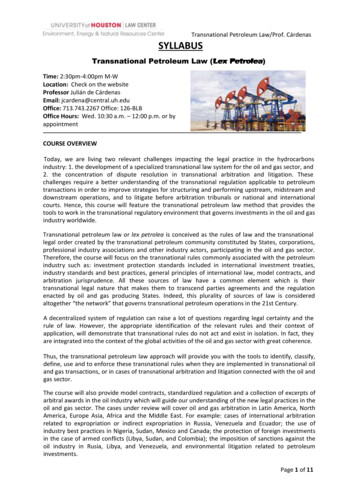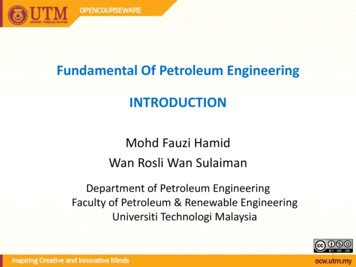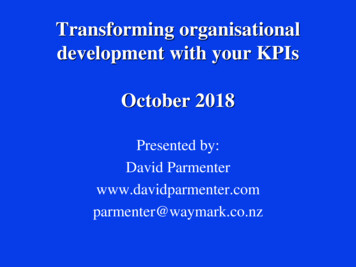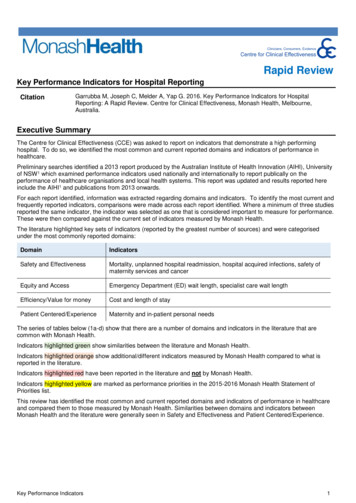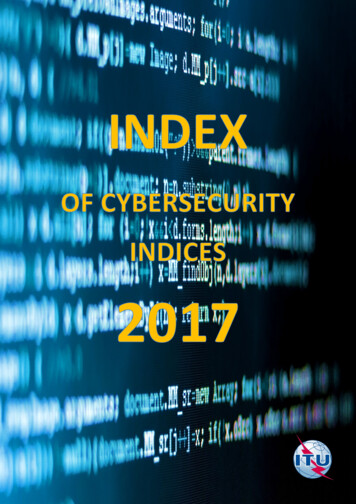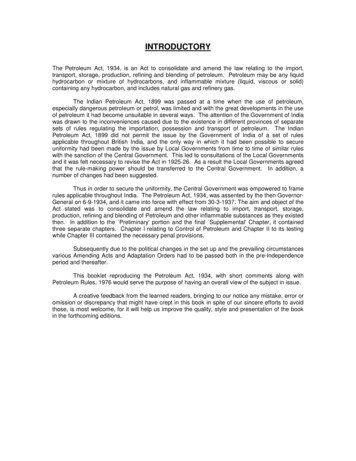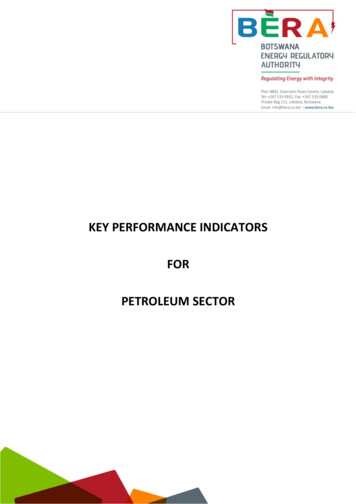
Transcription
KEY PERFORMANCE INDICATORSFORPETROLEUM SECTOR
INTRODUCTION1.0BACKGROUND AND SCOPE1.1. BACKGROUND1.1.1. Sections 33 (2) (g), (i) and (j) of the BERA Act requires the Authority to establishtechnical codes and performance monitoring methodologies for licensees andregulated entities. This is derived from the function that the Authority shall; ‘monitorand inspect licensees and enforce licence conditions’ as stated in Section 6 (2) (g) ofthe Act. It is in this premise that the Authority develops Key Performance Indicators(KPIs) that can be used to monitor licensees in the petroleum businesses.1.2. SCOPE1.2.1. This document covers key performance indicators for petroleum licensees undervarious licences such as manufacturing, retail and storage facilities.1.2.2. The Authority shall upon entering into force of these KPIs use them to monitorperformance of petroleum operators.1.2.3. Performance shall be published by the Authority from time to time to encourageoperators to adhere to high performance standards and induce competitionamongst operators.Page 2 of 9
2.0KEY PERFORMANCE INDICATORS2.1KPIs have been identified and categorised as follows; public health and safety,environment, consumer service and protection and product quality as prioritiesthat must be monitored to ensure high standards of performance. Targets areindicated in Table 1: KPIs for Petroleum Licensees.2.1.1 PUBLIC HEALTH AND SAFETYDuring the conduction of a regulated activity or within a regulated facility, alicensee is expected to conduct its business in a manner that does not poseunmitigated risks to the public, consumers, its employees and neighbours. It istherefore imperative that incidents and accidents are recorded, investigated andall risks are mitigated appropriately. Safety, Health, Environment and Quality(SHEQ) Policy must be available and displayed alongside with the licence.2.1.1.1 Fatality – death resulting from conduction of a regulated activity;this must be reported immediately.2.1.1.2 Lost time injury (LTI) – this refers to an injury that causespermanent disability or that which the injured person may notreturn to work a day after the incident; LTIs must be reportedwithin twelve hours of occurrence.2.1.1.3 Fire Incidents – any incident resulting in a fire at regulated facilitymust be reported within twelve hours of occurrence.2.1.1.4 Vehicle Accidents – any accident involving a vehicle/vesseltransporting petroleum products that has the potential to causeany or all of the following; fire, petroleum product spill, fatality orlost time injury. These must be reported within twelve hours ofoccurrence.2.1.2 ENVIRONMENTAL PROTECTIONWhilst environmental protection mandate sits with the Department ofEnvironmental Affairs, the Authority has been given a responsibility under itsfunctions (Section 5 (e)) to protect and preserve the environment. It is in thisregard that licensees are expected to conduct their businesses in a manner thatdoes not cause unmitigated risk to the environment.Page 3 of 9
2.1.2.1 Petroleum Product Spill – refers to any uncontrolled loss ofcontainment of more than two hundred litres in one instant. Spillsmust be reported within twelve hours of occurrence and must becontained and managed consistently with the applicable legislationor standards.2.1.2.2 Minor spill – minor spills refers to any uncontrolled loss ofcontainment not exceeding two hundred litres in one instant suchas overfill spills or drips during re-fuelling of vehicles. Whilst theseare not reportable, the licensee is expected to ensure that there isproper drainage and oil separators designed according to theapplicable standards to control these spills so that they do notpollute the environment or underground water. Consistent withthe applicable standards the licensees shall be required to drill andmaintain leak observation wells for monitoring environmentalcontamination on accordance with applicable standards.2.1.3 PRODUCT QUALITYPetroleum licensees are expected to only stock, offer for sale and sell productswhich conform to the specified quality in the applicable standards. The Authoritymay conduct random sampling and testing of products at facilities from time totime and these must conform at any given time. It is the responsibility of anylicensee to ensure that the product they receive from their supplier conforms tothe standard.2.1.3.1 Product Quality Incidents – this refers to any incident in which theproduct is either contaminated or cross mixed with anothertherefore compromising its quality or performance parameters.Where a licensee decides to add some additives for marketingpurposes, such additives must not compromise or alter thespecified quality of the product. These must be reportedimmediately after determining that such has occurred.2.1.3.2 Water Contamination – this refers to product contamination dueto presence of water in the storage tanks that is above theallowable limit specified in the applicable standards. Licensees areexpected to regularly monitor and record water content in thestorage tanks. Where operators record water levels higher than theminimum set limit, they must close that particular tankimmediately until all the water has been pumped out to below thePage 4 of 9
minimum set limit. These incidents must be reported to theAuthority within twelve hours of occurrence.2.1.4 CONSUMER SERVICE AND PROTECTIONConsistent with the requirements of Section 63 of the Act, each licensee shall berequired to have a Code of Practice on Consumer Protection approved by theAuthority. Licensees must ensure that their processes do not infringe consumers’rights and where consumers complain against their products or services, theyresolve the complaints within set timelines without victimising the complainant.2.1.4.1 Consumer Complaints – This refers to complaints by consumersagainst a licensee for either the products or services received fromthe retail outlet. The operator is expected to record, resolve andreport to the Authority (as may be necessary) within the timelinesprescribed in the BERA Complaints Handling ProcedureRegulations.2.1.4.2 Product Stock Outs – this refers to the number of days the retailoutlet runs dry/out of stock. These must be reported to theAuthority within the time period prescribed by the Authority.2.1.5 TECHNICAL AND REGULATORY COMPLIANCELicensees are expected to comply with all regulatory requirements and technicalstandards prescribed by the Authority from time to time. Inspections, audits andinvestigations that shall be carried out by the Authority from time to time shall beused to determine the performance of the operator under this category. Thisincludes product quality sampling and testing as shall be conducted by theAuthority, general compliance to technical, environmental, safety standards,regulated prices, calibration of equipment and licence conditions.2.1.5.1 Non-compliances resulting in fines, suspension/revocation oflicence or closure of facilities shall be recorded and used tomeasure performance of the operator.2.1.5.2 Training of staff – operators must ensure that their staff are trainedat a bare minimum on; handling of petroleum products, firefightingand first aid.2.2Targets are indicated in Table 1: KPIs for Petroleum Licensees.Page 5 of 9
3.0KPI REPORTING3.13.23.34.0VERIFICATION OF KPIs BY THE AUTHORITY4.14.24.35.0Upon receipt of KPI reports from licensees the Authority shall scrutinize the datacontained therein.The Authority may conduct a verification audit (unannounced) in order to validatethe reported data.Where in the view of the Authority, the data submitted by the licensee is incorrector undeserved or where the licensee fails to submit the report by the set deadlinedate, the Authority’s assessment shall prevail.PUBLISHING OF PERFORMANCE5.15.25.36.0Licensees shall submit to the Authority their performance assessment reportquarterly.The report shall be as per Table 2: KPIs Reporting Template for PetroleumLicensees.The report may be accompanied with explanatory notes where necessary.After verifying and validating the reports submitted by licensees the Authorityshall award a performance rating to each of the licensees.Performance ratings may be published by the Authority on its website, media andany other platform that the Authority deems necessary.The Authority may where it considers necessary establish a reward system for thehigh performers.REVIEW OF KPIs6.16.2The Authority shall review the KPI Framework every twenty four months from thedate of its implementation.Any amendments emanating from reviews shall be communicated to the relevantstakeholders and the public.Page 6 of 9
Table 1: Key Performance Indicators for Petroleum SectorIndicatorDefinitionInterpretationTarget2.1.1 1FatalityDeath resulting fromconduction of aregulated activityZero (0)2.1.1.2 Lost timeinjuriesAn injury that causespermanent disabilityor that which theinjured person maynot return to work aday after the incidentAny incident resultingin a fire at retail outletmust be reportedwithin twelve hours ofoccurrenceIndicative of theeffectiveness ofthe safetysystems in placeIndicative of theeffectiveness ofthe safetysystems in placeZero (0)Twelve (12)hours fromoccurrenceIndicative of theeffectiveness ofthe firepreventionmechanisms inplaceIndicative of theeffectiveness ofthe transportsafetymanagementsystems in placeZero (0)Twelve (12)hours fromoccurrenceZero (0)Twelve (12)hours fromoccurrenceIndicative of theeffectiveness oftheenvironmentalmanagement(protection)systems in placeIndicative of theeffectivenessand integrity ofthe drainage andoil separatorsystems in placeIndicative ofadherence toProduct QualityZero (0)Twelve (12)hours fromoccurrenceZero (0) soilcontamination.Twelve (12)hours fromoccurrence ofany soilcontamination.Zero (0)Immediatelyafter2.1.1.3 Fire2.1.1.4 Vehicleaccidents2.1.2.1PetroleumProduct SpillAny accident involvinga vehicle/vesseltransportingpetroleum productsthat has the potentialto cause any or all ofthe following; fire,petroleum productspill, fatality or losttime injuryAny product spill ofmore than twohundred litres in oneinstant2.1.2.2 MinorSpillAny uncontrolled spillnot exceeding twohundred litres in oneinstant2.1.3.1 ProductQualityAny incident in whichthe product is eithercontaminated or crossPage 7 of 9ReportingTimelineImmediately
2.1.3.2 WaterContamination2.1.4.1ConsumerComplaints2.1.4.2 ProductStock Outs2.1.5.1 NonCompliances2.1.5.2 Untrained Staffmixed with anotherthereforecompromising itsquality orperformanceparametersProductcontamination due topresence of water inthe storage tanks thatis above the allowablelimit specified in theapplicable standardsComplaints byconsumers against aretail outlet for eitherthe products orservices received fromthe retail outletspecificationsapproved by theAuthorityIndicative ofeffectiveness ofthe watereliminationsystem in placeIndicative ofadherence toandeffectiveness ofthe Code ofPractice onConsumerProtectionThe number of daysIndicative of thethe retail outlet runsadherence todry/out of stocklicenceconditions andeffectiveness ofthe supplylogistics systemsin placeFines,Indicative ofsuspension/revocation adherence to theof licence or closure of licencefacilitiesconditions, BERAregulations andActrequirementsOperators mustIndicative ofensure that their staff adherence toare trained at a barelicenceminimum on; handling conditionsof petroleumproducts, firefightingand first aidPage 8 of 9determiningoccurrenceTwo (2)Twelve (12)hours fromoccurrence100% timeouscomplaintresolution rateIn accordancewith BERAComplaintsSettlementProcedureRegulationsTwo (2)In accordancewith BERAPetroleumRegulations100%N/ACompliance LevelZero (0)N/A
Table 2: KPIs Reporting Template for Petroleum SectorCompany Name: Address: .Phone: Licence Number: .Next Renewal Due Date: .Reporting Period: 1.2.2FatalityLost time injuriesFireVehicle accidentsPetroleum Product SpillSoil contamination dueMinor Spills2.1.3.1 Product Quality2.1.3.2 Water Contamination2.1.4.1 Consumer Complaints2.1.4.2 Product Stock Outs2.1.5.1 Non-Compliances2.1.5.2 Un-trained StaffTargetActualTime ualresolutiontime)N/AN/AN/AN/AZero (0)Zero (0)Zero (0)Zero (0)Zero (0)Zero (0)Zero (0)Two (2)100% Timeouscomplaintresolution rateTwo (2)100% ComplianceLevelZero (0)Reported by: . (Authorised Operator Representative)Signature: .(Position in the Company) Date: Verified by: . .(BERA Representatives)Signature: Date: Approved by: . (For/Chief Operations Officer BERA)Signature: Date: Page 9 of 9
the Act. It is in this premise that the Authority develops Key Performance Indicators (KPIs) that can be used to monitor licensees in the petroleum businesses. 1.2. SCOPE 1.2.1. This document covers key performance indicators for petroleum licensees under various licences such as manufacturing, retail and storage facilities. 1.2.2.
